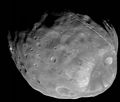Vaizdas:Phobos colour 2008.jpg

Šios peržiūros dydis: 636 × 600 taškų. Kitos 6 rezoliucijos: 255 × 240 taškų | 509 × 480 taškų | 815 × 768 taškų | 1 086 × 1 024 taškų | 2 172 × 2 048 taškų | 3 500 × 3 300 taškų.
Didesnės raiškos iliustracija (3 500 × 3 300 taškų, rinkmenos dydis: 2,72 MiB, MIME tipas: image/jpeg)
Rinkmenos istorija
Paspauskite ant datos/laiko, kad pamatytumėte rinkmeną tokią, kokia ji buvo tuo metu.
| Data/Laikas | Miniatiūra | Matmenys | Naudotojas | Paaiškinimas | |
|---|---|---|---|---|---|
| dabartinis | 06:10, 2 balandžio 2018 |  | 3 500 × 3 300 (2,72 MiB) | Kaldari | more margin on right side |
| 07:47, 13 lapkričio 2008 |  | 3 374 × 3 300 (2,7 MiB) | Fir0002 | == Summary == {{Information |Description=Colour image of Phobos, imaged by the Mars Reconnaisance Orbiter in 2008 |Source=NASA |Date=9 April 2008 |Location=http://www.nasa.gov/mission_pages/MRO/multimedia/pia10368.html |Author=NASA/J |
Paveikslėlio naudojimas
Paveikslėlis yra naudojamas šiuose puslapiuose:
Visuotinis rinkmenos naudojimas
Ši rinkmena naudojama šiose viki svetainėse:
- Naudojama af.wikipedia.org
- Naudojama an.wikipedia.org
- Naudojama ar.wikipedia.org
- المريخ
- فوبوس
- قمرا المريخ
- ويكيبيديا:صور مختارة/الفضاء والكون/نظرة إلى الأعلى
- قائمة أجرام المجموعة الشمسية مرتبة حسب الحجم
- بوابة:علم الفلك/صورة مختارة
- بوابة:المريخ/مقالة مختارة/أرشيف
- بوابة:المريخ/مقالة مختارة/2
- قائمة الأقمار الطبيعية
- خط زمني لاكتشاف كواكب المجموعة الشمسية وأقمارها
- ويكيبيديا:ترشيحات الصور المختارة/القمر فوبوس
- ويكيبيديا:صورة اليوم المختارة/أغسطس 2019
- قالب:صورة اليوم المختارة/2019-08-03
- بوابة:علم الفلك/صورة مختارة/73
- معسكر قاعدة المريخ
- ويكيبيديا:صورة اليوم المختارة/يناير 2022
- قالب:صورة اليوم المختارة/2022-01-04
- Naudojama ary.wikipedia.org
- Naudojama arz.wikipedia.org
- Naudojama as.wikipedia.org
- Naudojama azb.wikipedia.org
- Naudojama az.wikipedia.org
- Naudojama be-tarask.wikipedia.org
- Naudojama be.wikipedia.org
- Naudojama bg.wikipedia.org
- Naudojama bh.wikipedia.org
- Naudojama bn.wikipedia.org
- Naudojama bn.wikibooks.org
- Naudojama bs.wikipedia.org
Žiūrėti visuotinį šios rinkmenos naudojimą.






